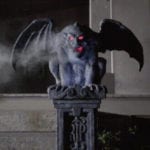 Politics
Politics  Politics
Politics  Humans
Humans The 20th Century’s 10 Most Famous Centenarians
 History
History 10 Influencers Who Lived Centuries before Social Media
 Miscellaneous
Miscellaneous 10 Ancient Etiquette Rules You Never Knew Existed
 Our World
Our World Planet Earth’s 10 Most Hardcore Natural Creations
 Movies and TV
Movies and TV 10 Times Twin Movies Competed with Each Other
 The Arts
The Arts 10 Masterpieces Plucked from the Artist’s Subconscious
 Crime
Crime 10 Fascinating Facts about Rikers Island
 Pop Culture
Pop Culture 10 Things You Might Not Know about Dracula
 Weird Stuff
Weird Stuff 10 Everyday Activities That Were Once Considered Illegal
 Politics
Politics 10 U.S. Presidents Who Cheated on Their Wives
 Humans
Humans The 20th Century’s 10 Most Famous Centenarians
 History
History 10 Influencers Who Lived Centuries before Social Media
Who's Behind Listverse?

Jamie Frater
Head Editor
Jamie founded Listverse due to an insatiable desire to share fascinating, obscure, and bizarre facts. He has been a guest speaker on numerous national radio and television stations and is a five time published author.
More About Us Miscellaneous
Miscellaneous 10 Ancient Etiquette Rules You Never Knew Existed
 Our World
Our World Planet Earth’s 10 Most Hardcore Natural Creations
 Movies and TV
Movies and TV 10 Times Twin Movies Competed with Each Other
 The Arts
The Arts 10 Masterpieces Plucked from the Artist’s Subconscious
 Crime
Crime 10 Fascinating Facts about Rikers Island
 Pop Culture
Pop Culture 10 Things You Might Not Know about Dracula
 Weird Stuff
Weird Stuff 10 Everyday Activities That Were Once Considered Illegal
10 Astonishing Discoveries That Transformed Ordinary People into Millionaires
Everybody has fantasized about hitting the jackpot at some point in their life. Whether you scour the ocean floor looking for sunken treasure, love sports betting or casinos, or even just play the lottery, everybody harbors a small flicker of hope that one day they can win big and change their lives for the better.
For most people, this payday and level of wealth will always remain an unattainable dream that few people are willing to invest time or money into achieving. But for the incredibly lucky few, great fortunes are still out there, just waiting to be discovered.
With that in mind, here are 10 examples of ordinary people who made astonishing discoveries that made them millions of dollars overnight.
Related: 10 Inspirational Rags-To-Riches Stories
10 Hand of Faith Gold Nugget, Australia: $1 Million
In the fall of 1980, Kevin Hillier and his family were traveling up and down the Australian coast in a van searching for work opportunities. Hillier had been making ends meet by doing odd jobs. However, after suffering a back injury, doctors had told him to cut back on the physical labor but to go walking to aid his recovery, which directly led to his interest in metal detecting.
Hillier’s wife often prayed they would discover their fortune through their newfound hobby, and Hillier once dreamed that he found a gold nugget that couldn’t be removed from the soil. But the family continued to struggle until one day in September 1980 when, outside his small hometown of Wedderburn, Victoria, Hiller’s dream became an unbelievable reality.
While out walking with his metal detector, Hillier really did discover a gold nugget that couldn’t (initially) be pulled from the ground. After many hours of careful digging, he managed to extract a gold nugget that weighed about 27.6kg (61 lbs.) which he sold in February 1981 to the Gold Nugget Casino in Las Vegas for over $1 million, where it remains the largest gold nugget on display anywhere in the world.[1]
9 Heade’s “Magnolias on Gold Velvet Cloth,” Indiana: $1.25 Million
In January of 1999, an unnamed man was playing a board game about fine art titled Masterpiece when he recognized a picture that was painted in a similar style to a painting he had bought to cover a hole in the wall of his Indiana home. Intrigued, he searched the internet until he came across information from the Kennedy Galleries in New York regarding the work of an American artist named Martin Johnson Heade.
After sending some pictures and a description of the painting in his home to experts at the gallery, the owner was shocked to learn that his acquisition was actually a lost work by Heade. The piece was still in its original frame, and it was in remarkable condition, considering it was painted in the 1890s.
Heade’s “Magnolias On Gold Velvet Cloth”—as the painting was titled—was eventually purchased by the Houston Museum of Fine Arts for more than $1 million after the board of trustees managed to raise the funds in a meeting that lasted less than 90 minutes.[2]
But don’t be discouraged, reportedly, there are many more lost or forgotten—and valuable—paintings just waiting to be found at your neighborhood thrift store, flea market, or rummage sale.
8 Declaration Of Independence, Pennsylvania: $2.42 Million
The Declaration of Independence is considered by many Americans to be the most important document in the nation’s history. After the original was created, 200 “first edition” copies were made by John Dunlap ‘ were made so the message of the Declaration could be carried across the nation. Of the 26 copies known to survive, only three of them are currently in the hands of private collectors.
One such copy was discovered behind a painting that a collector only bought because he liked the frame. Upon disassembling the frame, the unidentified owner found an “unspeakably fresh” first edition copy of the Declaration Of Independence folded up behind the picture.
An excited friend encouraged the owner to contact Sotheby’s to get it appraised and eventually it sold for $2.42 million at auction in 1991, with the price reflecting the unique nature of this discovery and the remarkable condition it was in. That same copy was auctioned by the 1991 auction wiiner again in 2000, bringing in $8 million.[3]
7 Hoxne Hoard, UK: $2.5 Million
In November 1992, a farmer was working his fields in Suffolk, England, when he realized that he had lost his hammer. Knowing it could take years to search for it alone and not willing to give it up as lost and buy a new one, he asked his friend Eric Lawes to bring his metal detector over and attempt to locate his missing tool.
Not long into the search, Eric picked up a signal, so he began digging in the soil where his reading was strongest. It quickly became apparent that he had not found the hammer but had instead stumbled across something much more exciting. After digging up a few shovels full of gold and silver coins, Eric quickly contacted police and local archeologists to inform them of his discovery. The very next day, a team of experts excavated the entire chunk of earth containing the coins so that they could be examined and extracted under laboratory conditions. It was only when the experts began the lab work that they realized the significance of Eric’s discovery.
Overall, Eric had found about 27 kilograms (60 pounds) of gold and silver objects, including over 15,000 coins that dated from the Roman occupation of Great Britain. Mr. Lawes received over $2.5 million from the British government as compensation for his remarkable discovery, which he split evenly with the landowner, who eventually found the hammer which had sparked the initial search.[4]
6 The Royal One, Black Opal, Australia: $3 Million
In 1999, a man known only as Bobby decided to sell all of his equipment and retire from an opal mining career that had lasted more than 20 years. Bobby lived in Lightning Ridge, a small mining community in New South Wales, Australia, and he found the stone in the very last bucket that had been mined.
Bobby worked carefully for months to reveal the beautiful opal, which he eventually named the Royal One. For reasons known only to him, Bobby inexplicably kept it under his bed (or in a kangaroo skin pouch around his neck) for more than 14 years despite having the expertise to know just how potentially valuable it was.
Eventually it was auctioned off in Santa Fe, New Mexico, in 2013, and the Royal One—a 306-carat high quality black opal—netted Bobby over $3 million.[5]
5 Tanzanite Stones, Tanzania: $3.4 Million
Tanzanite is an incredibly rare mineral that can only be found in one place on earth, the African nation of Tanzania, from which the gem gets its name. The rarity of tanzanite makes it extremely valuable, and mining this gem provides a valuable source of income for many budding entrepreneurs and treasure hunters in the country.
Out of all the people who spend their lives searching for tanzanite, Saniniu Laizer must be considered the luckiest. In June 2020, his mining operation in Tanzania recovered the two largest examples of the mineral ever recorded, weighing 9.3 kilograms (20 pounds) and 5.1 kilograms (11 pounds), which he sold to the Tanzanian government for more than $3.4 million.
Amazingly, Laizer wasn’t ready to retire with his new fortune. Just two months later, in August 2020, reports suggest that he found another huge piece of Tanzanite weighing 5.3 kilograms (14 pounds), worth an estimated $2 million.
Laizer has 30 children to care for, but he still promises to build a school and a medical center with his newfound wealth in an attempt to help all the people who live in his impoverished community.[6]
4 Crosby Garrett Roman Helmet, Cumbria UK: $3.6 Million
In the UK, important archeological finds must be reported to the relevant authorities upon discovery. Certain valuable metals such as gold and silver are not permitted for private sale, so just like the previously mentioned Hoxne Hoard, a “finder’s fee” is paid to anyone who discovers and reports valuable historical artifacts. The finds are then acquired by local museums, where they can be studied and viewed by the public.
The next item, however, wasn’t covered by these laws as it was made from bronze, which is only considered treasure if it is part of a hoard. Since this object was discovered on its own, it could be sold privately, which was great news for the pockets of the unnamed person who found it!
The artifact in question is a bronze, ceremonial Roman cavalry helmet in unbelievable condition for its age. It was discovered by an amateur metal detectorist on a Cumbrian farm in the UK in May 2010. It’s one of only three Roman helmets to be found in Britain with a complete facemask. Because of its rarity and the fact it could be purchased by anybody, the helmet eventually sold for $3.6 million, which was paid by a private collector at an auction in October 2010.[7]
3 Staffordshire Hoard, UK: $4.3 Million
An amateur metal detectorist named Terry was searching a field in Lichfield, England, in July 2009 when he came across an area with a uniquely strong signal. Almost immediately after breaking the surface of the ground, the man knew he had discovered something special as he started to uncover an astonishing stash of gold, weapons, and ornaments that had lain undisturbed beneath the surface for over 1,300 years.
What has become known as “The Staffordshire Hoard” was essentially a “war hoard” dating from 600–650, which was an especially turbulent period of England’s history. Experts believe that the items were captured in battle by armies from the kingdom of Mercia, which was at war with the neighboring regions of Northumbria and East Anglia at the time. Although, how it came to be buried in a field far from any known buildings or roads, we will probably never know.
The hoard was purchased by the Birmingham Museum for more than $4.3 million and is still available for the public to view. The money was split evenly between metal detectorist Terry Herbert and landowner Fred Johnson.[8]
2 “Christ Mocked” By Cimabue, France: $26.8 Million
This story is remarkably similar to that of Heade’s “Magnolias on Golden Gold Velvet Cloth,” which originally covered a hole in a wall. However, this painting, “Christ Mocked” by Cimabue, hung over a stovetop in a French farmhouse for decades. Thought to be a Russian religious relic, the paint was darkened by the stove’s heat, and the whole thing was covered in dirt and grease. This tiny masterpiece was eventually discovered in September 2019 by an auctioneer categorizing the belongings of the elderly owner who was moving out of the old house and into a retirement home.
Upon closer inspection and after some cleaning, it was realized that this was one of only 11 known paintings created by the Italian artist Cimabue. The painting was put up for auction. It was purchased by two U.S.-based collectors who specialized in Italian Renaissance art, but the French government imposed a 30-month ban on the export of the painting with the hope that it could quickly raise enough money to buy it so that the painting could remain in France and eventually be displayed in the Louvre.[9]
1 The Third Imperial Easter Egg by Fabergé, USA: Roughly $33 Million
The Russian Revolution is famous for many things: the eventual rise of communism, the demise of the Romanov royal family (the last monarchs in Russian history), and the confiscation and eventual sale of numerous golden bejeweled eggs created by the master artist, Peter Carl Fabergé, by the incoming regime.
Fabergé eggs not only hold remarkable value because of the cost of materials used in their creation and their fabulous designs but also because they are the last remaining relics of a royal family and a way of life that no longer exists in Russia today.
You would think that with their incredible notoriety, Fabergé eggs would be quite easy to identify and locate, but due to the secretive nature of Stalin’s sales of the eggs to private buyers in Western countries, eight of the Imperial eggs created for members of the Russian royal family are still missing today.
So when a man from the midwest happened across the Third Imperial Easter Egg at a jumble sale, the intention behind him spending $14,000 on acquiring this unique piece of art was not based on knowledge of art or Russian history, but from a desire to melt it down and profit from the raw materials that the egg consisted of. Upon appraisal, however, the unnamed man realized that he had paid more than the egg’s gold and jewels were worth, and he was worried that he had made a colossal error that would cost him a lot of money.
In desperation, the man searched the words “egg” and “Vacheron Constantin” (the words engraved around the clock) into Google and stumbled across an article in a British newspaper.
To the scrap metal dealer’s astonishment, the egg he thought would lose him money was actually worth something in the region of $33 million, and in 2014, the egg was purchased by a private collector for an unknown price.[10]








